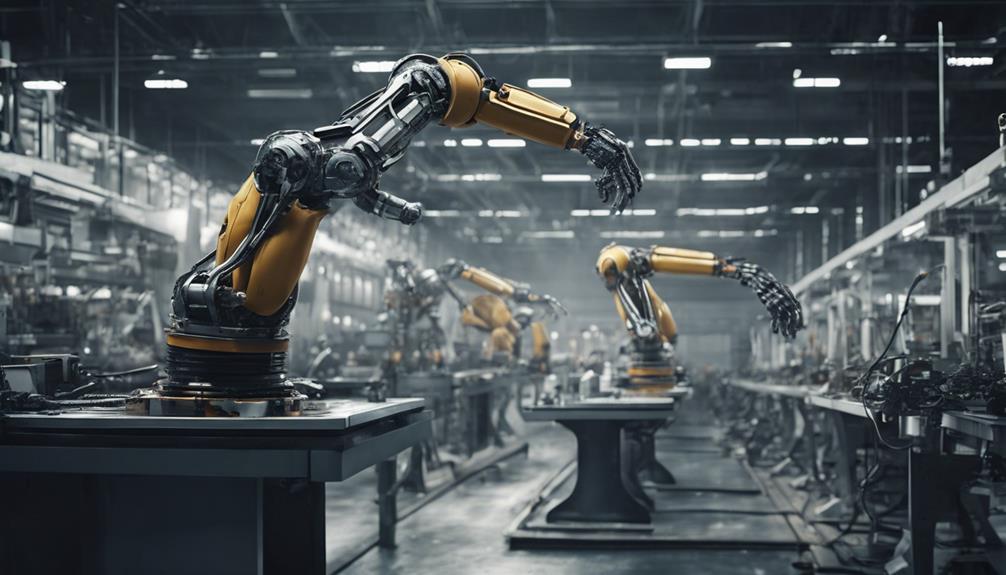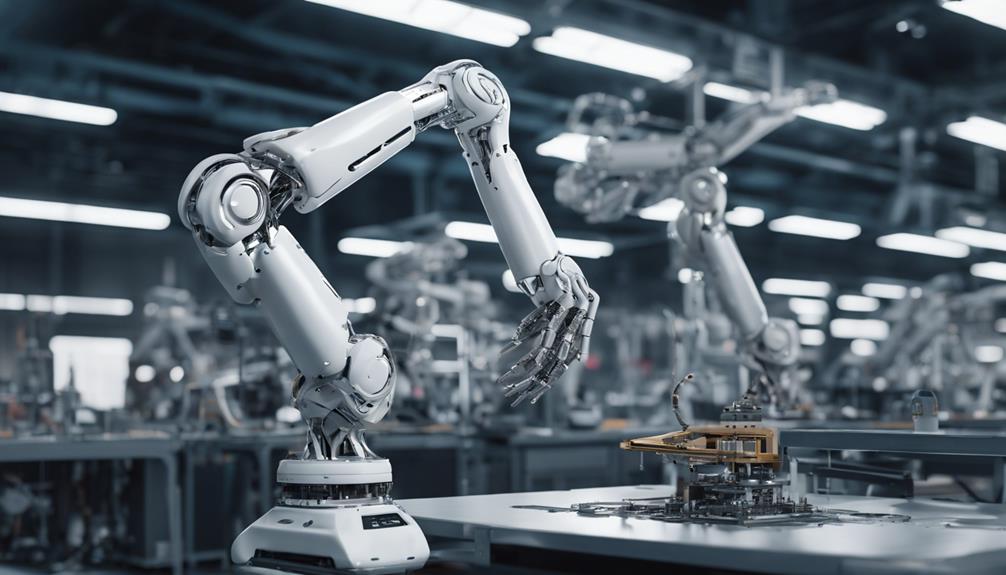The integration of technology into various industries has brought about major shifts in the job market, particularly in roles that used to be mainly held by humans. From manufacturing to customer service and retail, automation and artificial intelligence are now assuming tasks that were traditionally performed by people.
As advancements like self-driving technology, robotics, and self-service kiosks continue to redefine the way tasks are executed, the impact on employment patterns becomes increasingly pronounced.
The evolving relationship between technology and human labor prompts a critical examination of the future of work and the skills needed to adapt to this changing dynamic.
Key Takeaways
- Industrial robots like Baxter and Sawyer are transforming manufacturing processes.
- AI in customer service reduces costs and enhances efficiency through automation.
- Agricultural robots revolutionize farming with 24/7 efficiency and increased productivity.
- Self-service kiosks in retail streamline transactions, reducing the need for human cashiers.
Automation in Manufacturing
The increasing integration of computer-controlled robots in manufacturing processes is fundamentally reshaping the landscape of industrial production, displacing traditional human labor with more efficient and cost-effective automation solutions. Industrial robots such as Rethink Robotics' Baxter and Sawyer are at the forefront of this transformation, revolutionizing manufacturing by efficiently producing millions of unique products. The adoption of smarter and more affordable robots like these is on the rise in manufacturing processes, leading to a significant reduction in human labor and increased efficiency within the manufacturing sector.
Automation in manufacturing is not only streamlining production but also enhancing precision and consistency in tasks that were traditionally performed by assembly-line workers. These robots are capable of handling a wide range of functions, from simple repetitive tasks to complex operations, making them versatile assets on the factory floor. As the reliance on industrial robots continues to grow, the manufacturing industry is experiencing a shift towards a more automated and technology-driven future.
AI in Customer Service

Incorporating AI technologies into customer service operations is revolutionizing the way companies interact with their clients, shaping a more efficient and automated approach to handling inquiries and support services. AI technologies such as chatbots and virtual assistants are increasingly replacing traditional phone operators and customer service representatives, leading to significant cost savings for companies.
Automation in customer service not only improves response times and efficiency but also streamlines processes. Voice recognition and speech synthesis technologies play a crucial role in automating interactions with customers, reducing the need for human intervention and enhancing the overall customer experience.
- AI technologies like chatbots and virtual assistants are replacing phone operators and customer service representatives in various industries.
- Automation in customer service has led to significant cost savings for companies while improving response times and efficiency.
- Voice recognition and speech synthesis technologies are being used to automate interactions with customers, reducing the need for human intervention.
- Companies are increasingly adopting AI-powered systems to handle customer inquiries, complaints, and support services.
Robotics in Agriculture
As technology continues to advance across various industries, the integration of robotics in agriculture is rapidly transforming traditional farming practices. Agricultural robots are revolutionizing the farming industry by taking on tasks such as planting, harvesting, and weeding that were traditionally performed by humans. These robots offer the advantage of working 24/7, significantly increasing efficiency and productivity on farms. Automation in agriculture not only streamlines operations but also reduces the physical strain on workers, minimizing the need for manual labor.
Moreover, the implementation of precision agriculture techniques with robots leads to improved crop yields while simultaneously decreasing the reliance on pesticides and fertilizers. This shift towards robotics in agriculture signifies a significant technological advancement in the farming sector. As technology continues to progress, the adoption of agricultural robots is expected to grow further, enhancing the overall sustainability and productivity of the agricultural industry.
Self-Service Kiosks in Retail

With the rise of self-service kiosks in the retail sector, a notable shift towards automated transactions and reduced reliance on human cashiers is being observed. Retail stores are increasingly embracing self-service kiosks as part of their operations to enhance efficiency and customer convenience. These automated systems allow customers to scan and pay for items independently, minimizing the need for interaction with human staff. The implementation of self-service technology not only streamlines transactions but also caters to the growing demand for quick and seamless shopping experiences.
Key Points:
- Self-service kiosks in retail stores have decreased the requirement for human cashiers.
- Customers can scan and pay for items independently, reducing the need for staff interaction.
- Retailers adopt self-service technology to streamline transactions and enhance efficiency.
- Self-service kiosks offer convenience by handling multiple transactions simultaneously.
Drones in Delivery Services
The integration of drones into delivery services is revolutionizing the efficiency and speed of transporting packages, especially in remote areas, as companies like Amazon lead the way in testing and implementing drone delivery systems.
Drones have become a crucial part of logistics operations, offering an efficient and automated solution for delivering goods to even the most isolated locations. By utilizing drones, companies can significantly reduce delivery times and costs, making the transportation industry more streamlined and cost-effective.
Automated drones are capable of reaching destinations faster than traditional delivery methods, showcasing their potential to transform the way packages are transported. This shift towards drone delivery services is reshaping the industry, with businesses recognizing the value of incorporating this innovative technology into their operations.
As drones continue to evolve and improve, they are poised to become a cornerstone of modern delivery services, offering a glimpse into a future where speed and efficiency are paramount in the transportation of goods.
Frequently Asked Questions
Which Jobs Are Being Replaced?
The evolving landscape of job roles is witnessing a transformation where technological advancements are replacing traditional human jobs across various sectors. This shift is evident in roles such as cashier, phone operator, data entry worker, lift operator, and switchboard operator.
What Machine Has Replaced Human Labor?
Efficiency-enhancing machines like automated pin-setting machines in bowling alleys, digital printing technology in the printing industry, and packaging machines in industries have replaced human labor, optimizing processes, cutting costs, and boosting productivity.
What Technology Is Replacing Manual Labor?
Automation technology is gradually replacing manual labor across various industries, enhancing efficiency and accuracy. By utilizing computer-controlled systems and robots, tasks that were traditionally done by hand are now being performed with precision and speed.
What Other Once Human Jobs Are Done Now by Technology?
In today's rapidly evolving landscape, technology continues to redefine the workforce. Various traditional roles, once performed by humans, are now seamlessly executed by machines, demonstrating the transformative power of innovation in our modern economy.
Conclusion
In conclusion, the integration of technology in various industries has led to the replacement of human jobs with automation and robotics. According to a recent study by the World Economic Forum, it is projected that by 2025, automation will displace 85 million jobs globally in sectors such as manufacturing, transportation, customer service, retail, and agriculture.
This shift towards technology-driven solutions highlights the need for upskilling and reskilling of the workforce to adapt to the changing job market landscape.









